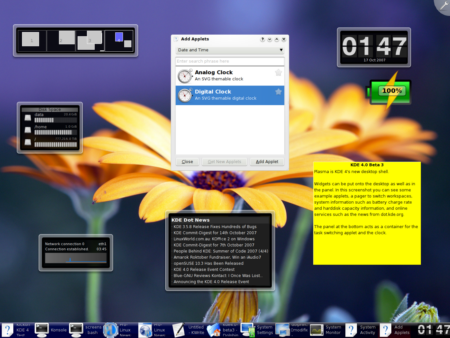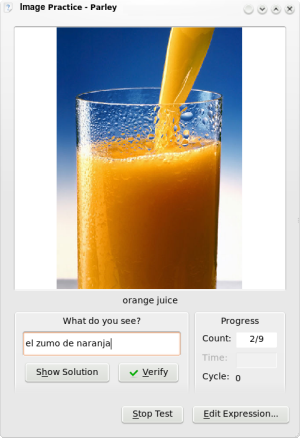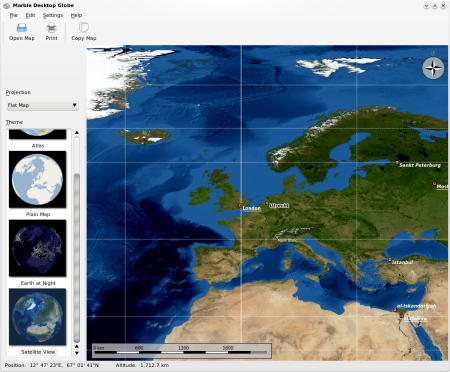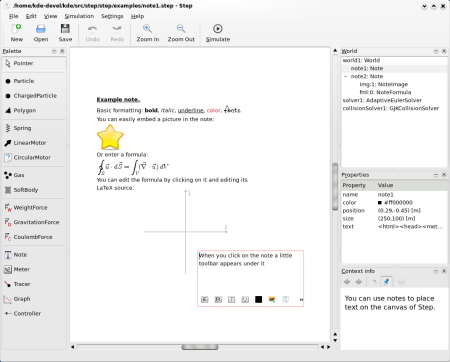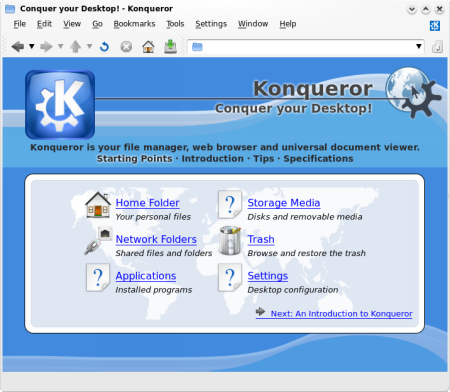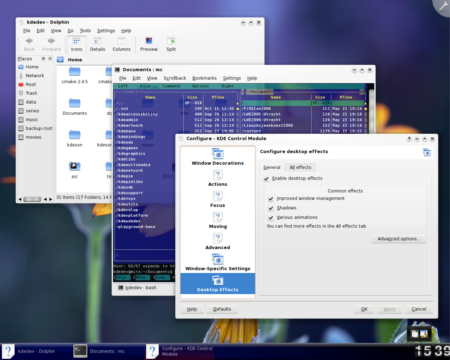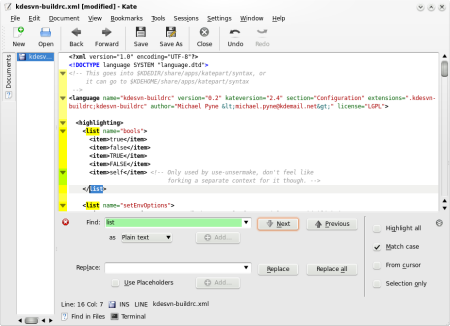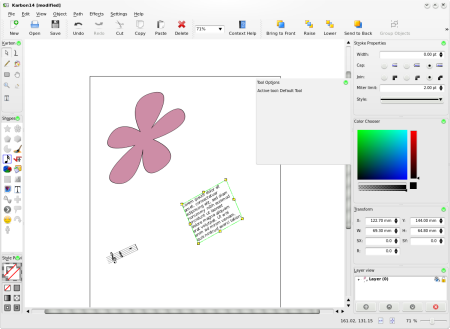KDE 4.0 Beta 3 Release Announcement
Wednesday, 17 October 2007
FOR IMMEDIATE RELEASE
KDE Project Ships Third Beta Release for Leading Free Software Desktop, Codename "Cicker"
With the third Beta, the KDE project has begun to finalize KDE 4.0.
The KDE Community is happy to release the third Beta for KDE 4.0. This Beta is aimed at further polishing of the KDE codebase and also marks the freeze of the KDE Development Platform. We are joined in this release by the KOffice project which releases its 4th alpha release, bringing many improvements in OpenDocument support, a KChart Flake shape and much more to those willing to test.
Since the last Beta, most of KDE has been frozen for new features, instead receiving the necessary polish and bugfixing. The components which were exempt from this freeze saw significant improvements as planned, and Aaron Seigo notes: "It is amazing to see the Plasma community growing. The pace of development is amazing, and we're getting really close to having all the features we want for KDE 4.0 available. After that, we have a solid foundation for implementing new and exciting user interface concepts for the Free Desktop".
About KDE 4
KDE 4 is the next generation of the popular KDE Desktop Environment which seeks to fulfill the need for a powerful yet easy to use desktop for both personal and enterprise computing. The aim of the KDE project for the 4.0 release is to put the foundations in place for future innovations on the Free Desktop. The many newly introduced technologies incorporated in the KDE libraries will make it easier for developers to add rich functionality to their applications, combining and connecting different components in any way they want.
The new Beta 3 incorporates many improvements from previous Beta and alpha releases: Alpha 1, Alpha 2, Beta 1 and Beta 2.
Beta 3
With the third Beta, KDE aims to show the progress on their new development platform and desktop. We hope to collect comments and ideas, and inspire developers to use our technology for their applications. Most applications in KDE 4.0 Beta 3 are ready for bug reports, like Dolphin, Konsole, Okular and most of the Games and Educational applications. Of course, the parts which aren't released with the Beta like KDevplatform, KDevelop and kdewebdev generally aren't ready for a load of bugreports, and the same goes for the components of KDE which are still exempt from the feature freeze like Plasma. We would really appreciate if you would have a look at the relevant documentation if you start reporting bugs! And remember, if you have a little time to kill, our Bugsquad can really use your help. All this feedback and support will help us to polish KDE and ensure stability of the final release.
Improvements
This Beta has mostly been focussing on finalizing the design of the libraries in preparation for the release of the KDE Development Platform. Yet, many user-visible changes have gotten in as well. While new features and usability improvements were added, bugs were found and fixed in KDE and the stability of Beta 3 has improved much compared to the previous Betas. In the following sections, we will try to highlight some visible improvements in Beta 3 compared to Beta 2. Since work has been done all over KDE, please note that this is not a complete overview of all changes!
Plasma
Plasma, one of the more exciting components of KDE 4 has seen a lot of work again. Aaron Seigo noted the changes since last Beta:
Plasma now provides a basic set of working components such as taskbars,
panels, desktop wallpapers, etc. Most of the foundational work for 4.0 has
been completed and now the focus is on integrating all the individual pieces
we've been working on for the last months into a single whole. Given that
Plasma is highly modular, supporting feature adds through six different kinds
of plugins and scripting languages, this task is made easier. The new menu,
based on the KickOff design developed in the openSUSE labs, has been
successfully developed as a separate component due to this approach. The bulk
of this integration work, and therefore the emergence of the Plasma concept,
will be seen in the upcoming release candidates.
KDE PIM status update
The KDE PIM project has been busy with their new infrastructure, Akonadi, which is planned for KDE 4.1. Their plans for the KDE 4.0 release ranged from improvements (KBlog, KAlarm, KOrganizer), feature-parity with KDE 3.5 (KAddressbook, KMail) to "probably won't be ready" (KPilot). Users would be able to use KDE PIM applications from the 3.5 series, which have incorporated many fixes and improvements in the last year, thanks to the work of KDAB and other developers on the enterprise branch. Those changes, mostly small features and many bugfixes, will probably be merged back into the KDE 3.5 series for a future release, and the branch is already shipped by default by many distributions. Of course, those improvements also made it into the KDE 4 versions of the KDE PIM applications. In the following paragraphs, I will expand on several of the applications in KDE-PIM.
KAlarm has been completely ported to KDE 4, and has already received several new features and improvements. It now supports multiple alarm resources and sharing these, allowing for sharing alarm calendars between laptop and desktop computer. It also correctly handles timezone and daylight savings changes, and can restrict alarms to working hours. Display alarms became more flexible, as the alarm message window can now show text from the output of a command. The edit alarm dialog has seen some usability work as well.
KPilot's hard-working team of 2.5 have been spending their time getting as much done in preparation for KDE4 as possible. KPilot's library, daemon, main UI, and configuration screens have been ported and are operational. Due to a very productive Summer of Code project and lots of Real Life (TM) thrown in, not all of the old conduits have been ported yet, which means that calendar, todo, and address syncing won't be functional until KDE's 4.1 release. The good news is that 3.5.8's KPilot is the most stable release to date. The focus in KPilot for KDE4 has been to clean up as much cruft as possible, to establish a solid foundation that all of the conduits will now share, and to create a new conduit in place to exercise that base code (namely, Bertjan's new keyring conduit).
Due to some works in the KDE libraries by KAlarm's David Jarvie, KOrganizer now has better timezone support. For each event, you can now express the dates and times in the timezone of your choice. Or you can say "I have a phone meeting at 10:00am, Moscow time" and it will appear in your own timezone on your schedule. In the agenda view, you can display timescales from different timezones so you can see when your events occur, both in your local and the other timezones.
Educational Software
As we have come to expect, a lot of work has been going on in the educational area. Last month saw improvements in Marble, Parley (formerly known as KVoctrain) and bugfixes in various other applications. The KDE EDU community is also planning a meeting which will be held in Paris and supported by Mandriva.
KVoctrain, an application which can be used to train language vocabulary, received usability work, features and a namechange. The new name, Parley, points to a discussion or conference, especially one between enemies over terms of a ceasefire or other matters. This fresh name is fitting for the shiny new interface. It became much easier and intuitive to start and display lectures, and the practice GUI got improved as well. You can now skip configuration - just enter some words or get a vocabulary file through Get Hot New Stuff to practice, hit "practice" and you are on your way. Frederik Gladhorn also got to implement a three year old wish thanks to the new and easy "start test" dialog, making it possible to use arbitrary language combinations. Finally, Parley became more colorful when the picture support was added, which enables users to practise with pictures as well.
The Marble project won a prize at the QtCenter contest: it was first in the Desktop Application category and third in the Custom Widget category. Work was done as well, thanks to the work by Carlos Licea, it sports a new 2D projection where you can view the earth like a map. Marble also retrieves Wikipedia articles about cities you select.
Step, an interactive physics simulator, received the ability to embed formulas in notes on the scene. Teachers can use this to annotate demonstrations of physical problems for their pupils, including the relevant formulas.
On Saturday the 15th of October, the KDE-Edu team had a polish day. This lead to many fixes and improvements, most notably in Blinken, KGeography, KHangMan and Marble. Also a global sound issue has been fixed in all Edu apps, and currently there is investigation going on in the Get Hot New Stuff area.
After all this work, the edu team is now shifting gears and focusing on stabilization and translation work, though there still are some things in the pipeline.
Various other improvements
At first, it seemed Kopete (KDE's multi-protocol instant messenging application would not make it for KDE 4.0, but luckily, the developers decided to make KDE 4.0 with Kopete happen. So we can expect Kopete to ship with KDE 4.0, basically as a straight port from KDE 3 to KDE 4. The Roadmap already describes the status and many plans for 4.1 (Kopete 1.0) and further.
The KDE image viewer Gwenview, moved to the kdegraphics module for KDE 4, received lots of integration and usability work. It now uses the location widget introduced in the filemanager Dolphin, and has now support for image resizing and cropping. A sidebar has been added showing metadata, and the slideshow feature is now configurable within fullscreen mode. Gwenview has also been optimized for speed, it starts up much faster than its KDE 3 counterpart.
Konqueror received a cleaned up default profile and more polishing work.
Further time was spent on KWin, the KDE window manager. It now autodetects your graphics hardware, and configures itself automatically for optimal performance. Changing the KWin settings by hand, will give you a confirmation dialog which automaticall reverts back to previous settings after some time, making it more robust by automatically canceling broken settings. When KWin crashes due to problems with compositing, it will turn it off and restart itself. Finally, speed has been improved and many effect plugins have been updated.
KLinkStatus from kdewebdev, useful for anyone who builds websites is included in KDE 4 Beta 3, and in a much improved version compared to KDE 3. It has seen many speed optimizations, but also many new options to further specify how it should do its work. It can now find (and eventually remove) unreferred documents, has the possibility to recheck individual links or the whole session and respects the encoding of the HTML pages when showing the links. The UI got some improvements as well, making using the application easier and faster.
Users looking for documentation and information should have a look at the KDE documentation page.
For developers
As the KDE libraries were in freeze for big additions since the first Beta, work was mostly focussing on fine-tuning and fixing everything. With the upcoming KDE Development Platform release, the developers have really shifted gear to getting everything stable.
Marble is now available for runtime embedding in other applications throught the KPart technology so in time, it will be possible to use it to view GPS datafiles in Konqueror. Kalzium got KPartified as well.
Between all the other work and fixes, Plasma saw the addition of SVG Widgets, which are somewhat similar to the Superkaramba bar meters. These widgets can be easily used by developers in plasmoids.
Kolourpaint now supports remote colour schemes. KGet was integrated with Plasma, and Kate welcomes Find Selected function and Search Highlighting.
Documentation for developers can be found on TechBase. Here you will be able to find an architectural overview and plans for the future of KDE. Further, there are tutorials, manuals and API references.
Next up
While the last bits and pieces will be set in place in the coming weeks, as soon as the Betacycle objectives are met, we will start preparing our first Release Candidate. This marks the beginning of a short period where we will allow only the most important bugfixes in preparation for the release. But shortly before that, we will see the release of the KDE Development Platform, targeted at developers interested in KDE development.
Get it, run it, test it...
For those interested in getting packages to test and contribute, several distributions notified us that they will have KDE 4.0 Beta 3 packages available at or soon after the release. The complete and current list can be found on the KDE 4 Beta 3 Info Page, where you can also find links to the source code, information about compiling, security and other issues.KOffice Alpha 4
KOffice has just released Alpha 4. This is mainly a technology preview for those that are interested in the new ideas and technologies of the KOffice 2 series. This release has seen many improvements in OpenDocument support for KWord, KSpread and KFormula, many new formula functions for KSpread, fixes in Kexi and KWord and support for templates and animations in KSpread. Kword now also runs on Windows, and others will follow soon. Last but not least, KPlato has been improved and KChart now provides a Flake shape so that it can be embedded in any other KOffice application.
KOffice 2 is currently under heavy development. It is not meant as something to be used for any real work and can crash at any point. However, here are some of the highlights of the upcoming KOffice 2 series. Note that not all of the new technologies will be fully implemented in the first release, 2.0.
Also note that although KOffice is included in KDE 4.0 Beta 3, it has its own release cycle, and the first version of the KOffice version 2 series is expected around New Year 2007-2008.
Compiled by Jos Poortvliet with extensive help from the KDE community
About KDE
KDE is an international technology team that creates free and open source software for desktop and portable computing. Among KDE’s products are a modern desktop system for Linux and UNIX platforms, comprehensive office productivity and groupware suites and hundreds of software titles in many categories including Internet and web applications, multimedia, entertainment, educational, graphics and software development. KDE software is translated into more than 60 languages and is built with ease of use and modern accessibility principles in mind. KDE’s full-featured applications run natively on Linux, BSD, Windows, Haiku, and macOS.
Trademark Notices.
KDE® and the K Desktop Environment® logo are registered trademarks of KDE e.V..
Linux is a registered trademark of Linus Torvalds. UNIX is a registered trademark of The Open Group in the United States and other countries.
All other trademarks and copyrights referred to in this announcement are the property of their respective owners.
Press Contacts
For more information send us an email: press@kde.org
